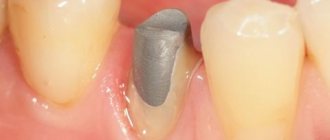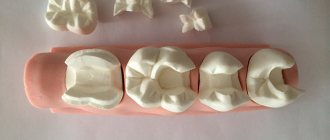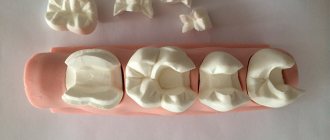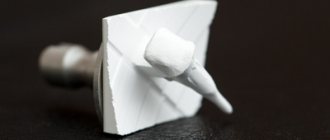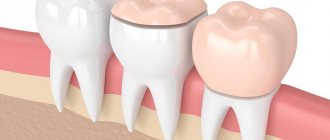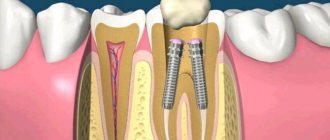If a tooth is destroyed by caries or as a result of injury, it must be restored, otherwise the tooth can be lost, and the absence of even one dental unit in a row is fraught with the most unpleasant consequences for health. For example, due to the absence of a tooth, an incorrect bite may develop, which leads to disruption of the correct process of chewing food and the development of various diseases of the digestive system.
If the tooth is slightly damaged, then most likely the doctor will use a regular, light-curing filling to restore it. But if the damage is significant, it would be more correct to use a stump tab.
Many people do not even know what kind of structure this is - a stump tab and for what purpose it is used by dentists. Meanwhile, the use of stump inlays makes it possible to successfully restore teeth that at first glance seem completely hopeless and must be removed.
In the article we will tell you in detail about what stump inlays are, what types of them exist, and why severely damaged teeth are best restored with inlays, and not with fillings and pins.
What is a stump tab and why is it needed?
A stump inlay is not a filling or a seal on a post. This is a specialized orthopedic design that is produced in a dental laboratory and is used to restore teeth that have been more than half destroyed by caries or trauma.
Of course, even a badly damaged tooth can be restored with a filling on a pin and then a prosthesis can be placed on it. But such an approach to prosthetics will be wrong, since large fillings, even if attached to pins, are simply not capable of holding well. The load on the tooth will sooner or later lead to the filling on the pin falling out along with the prosthesis, and then the tooth will have to be re-treated.
Stump inlays help to avoid such unpleasant consequences - they are firmly fixed in the root canal of the tooth and the dental crown is fixed on them. Externally, the inlays are very similar to stumps - ground teeth - hence their name.
General information about designs
Zirconium dioxide inlay - what is it? You need to understand that inlays in dentistry belong to the field of prosthetics, or more precisely, microprosthetics. That is, these are small-sized prostheses, which come in 2 types:
- restorative (or coronal): independently restore the integrity of the tooth,
- stump (or pin): serve as a support for another prosthesis - a crown, bridge, removable orthopedic structure.
Both restorative and pin inlays are made from zirconium oxide1 - we will describe below what each of these zirconium inlays is and what it looks like. It is worth noting that zirconium dioxide is a very strong material in compression and bending (more than 1400 MPa), in this it can even be compared with metal alloys. However, zirconium dioxide is more often called ceramics - more precisely, metal-free ceramics, since purely externally the material is white, like your own teeth.
%akc72%
Why are core inlays better than fillings and pins?
Fillings and pins are only applicable if the tooth has a sufficient amount of healthy tissue remaining. If only the root or thin walls of the tooth remain, then it cannot be restored with a pin, since such a restoration method will not be distinguished by either quality or reliability.
Firstly, under load, the pin can break and in the process damage the tooth root. Trauma to the root of a tooth is a direct indication for its removal; no methods for damaging the root system will help you save your tooth.
Secondly, dentures installed on large fillings and pins most often fall out some time after prosthetics. In this case, the treatment will have to be carried out again, and this implies new and significant financial costs.
IMPORTANT: Some dentists try to fix the fallen crown and pin with cement. But this is useless: the structure will not hold firmly, and in addition, an inflammatory process may begin under it, leading to rotting and destruction of the tooth.
Therefore, in case of severe tooth decay, only a stump inlay can provide high-quality and durable prosthetic results.
Types of materials
The type of stump inlays is related to the material used to make them. Dentists use types of prosthetic models made from:
- metal;
- metal ceramics;
- solid ceramics;
- composite materials.
Metal
They come in chrome-plated cobalt and precious metals. Such models are very durable, but not always aesthetically pleasing. Therefore, they are usually made for the chewing teeth, and not for the “smile zone”.
All-ceramic
They are made from a pressed type of ceramic with the addition of zirconium dioxide. In terms of strength, this type of inlay is no worse than metal ones, but the aesthetic component is similar to porcelain structures. Their disadvantage is their fragility, which is why they are used mainly for front teeth.
Modern automated technologies are used in the manufacture of all-ceramic dental structures. Thanks to this, such prostheses are absolutely protected from factors affecting antiseptics or manufacturing technology.
When installing all-ceramic inlays, you don’t have to worry about the addition of secondary caries.
Metal-ceramic
Metal-ceramic models often fall out, as their quality is somewhat “lame”. These troubles are associated with a discrepancy between the degree of expansion of ceramics and metal.
Composite inlay
Composite products are rarely used in modern dentistry. Such designs have few advantages over ordinary fillings, but they are expensive.
There is also a special type of core prosthesis for the restoration of anterior teeth (frontally located teeth).
Inlays made of either zirconium or titanium oxide are highly durable and do not cause such a serious complication after installation as an allergy to the metal.
The gold design is ideal for the body due to the fact that it does not react with other elements and is as hypoallergenic as possible. Dentists have long loved to work with gold: it does not break down and does not corrode, but is perfectly processed (and can also be melted or forged).
Most often, gold structures are used as a reliable option for restoring chewing teeth.
On the one hand, the silver model is good for use: who doesn’t know about the bactericidal properties of this metal? However, a serious disadvantage makes it rarely used for prosthetics: a characteristic oxide film around the reconstructed tooth, followed by darkening of the enamel and pigment spots in the gum area.
Chrome-plated nickel alloy is also used for this type of prosthesis. However, experts are aware of the disadvantage of this material in the form of severe shrinkage.
Types of stump inlays
Before installing a core inlay, it is imperative to treat the damaged tooth, remove all tissue damaged by caries, and also be sure to properly process and seal the root canals.
IMPORTANT: Root canal treatment is a process in which not the slightest mistake should be made! If the canals are treated poorly or improperly sealed, an inflammatory process may begin in them. In our dental clinic in Moscow - Firadent - treatment of tooth canals is carried out under a microscope, which allows the doctor to see the length and structural features of the canals and thus eliminate errors in the process of their treatment.
After treating the canals of the tooth, the orthopedic dentist begins to treat the patient: the specialist will unseal the canals to the length of the future stump inlay and take an impression for its manufacture. As we already wrote above, core inlays are produced in a dental laboratory.
There are several types of stump inlays. The classification of inlays is carried out according to the material of manufacture and the number of pins - fastenings with which the inlay will be firmly held in the tooth canals. The inlay may have several pins, their number is determined by the number of canals of the tooth being restored.
Based on the number of pins, the following types of stump inlays are distinguished:
- Single-rooted;
- Double-root collapsible and non-removable tabs;
- Three-root collapsible and non-removable stump inlays.
Multi-root inlays are most often made collapsible - this simplifies the process of securing the inlay in the tooth canals. But collapsible inlays are more expensive than non-demountable structures: the higher price is explained by the high complexity of manufacturing.
Manufacturing methods
- Straight. It is characterized by its low cost, ease of implementation, and does not require the presence of fire-resistant models or impression materials. With the direct protocol, the future core inlay is modeled in the oral cavity, and then dental laboratory specialists replace the wax with the working restoration material. Disadvantages: insufficient visibility of the surgical field, risks of thermal injuries to the mucous membrane, large time expenditure for the dentist.
- Indirect (indirect). It is used for all types of defects; production takes place in two stages: obtaining an impression plus obtaining a model.
Materials for manufacturing pin stump inlays
Stump pin inlays can be made from different materials - ceramics or metal. Stump inlays with metal pins are most often made from an alloy of cobalt and chromium and are used for the installation of metal or metal-ceramic prostheses.
Cobalt-chrome core inlays have a number of specific advantages:
- They have good biocompatibility with human body tissues;
- Stump pin inlays made of this metal alloy fit quite tightly to natural tissues and therefore, when used, the risks of caries, inflammatory processes and further tooth destruction are reduced;
- Cobalt-chrome alloy has high strength and therefore a crown installed on a pin insert made of this material will not shrink during operation.
Stump inlays made of cobalt-chrome alloy allow for proper distribution of the chewing load, which reduces the risk of cracks and tooth destruction. The advantages of inlays made from this material include their affordable cost.
Ceramic pin inlays are used for the installation of metal-free dentures. This allows you to obtain impeccable aesthetics of the restored tooth. If you place a metal stump insert under the ceramic structure, it can be quite noticeable and, of course, it will spoil the appearance of the restored tooth. Therefore, only ceramic pin inlays are placed under ceramics.
Advantages of microprostheses made of zirconium dioxide
If the question arises, which is better - a zirconium restoration inlay or a filling, then the first has the following advantages:
- more reliable: it is made of the strongest zirconium dioxide, and the filling is made of liquid composite or cement. In the future, these factors seriously affect the service life,
- more durable: a microprosthesis made of zirconium dioxide can last more than 20 years, and a large filling - on average 3-5 years, maximum about 7 years,
- tighter fit to the walls of the cavity: the microprosthesis is created in the laboratory using special equipment, and in exact accordance with the dimensions of the cavity - therefore it adjoins it without gaps. And over time, the tab, unlike a filling, does not peel off from the walls,
- does not wear off or sag during use: let us remind you that the material is extremely durable, which cannot be said about the filling - it begins to wear out and sag within a year after installation.
There are 2 moments when the filling wins. The first is if the cavity is very small, i.e. the microprosthesis will not be qualitatively fixed in it. The second is the front teeth, since they have a very thin cutting edge instead of an extensive chewing surface (like premolars and molars). More often, front teeth with small defects are restored with fillings or veneers - they, by the way, can also be made of zirconium dioxide. Restorative (pinlay varieties) in some cases can be placed on the lingual surface of an incisor or canine.
Patients often ask which inlays are better – fiberglass or zirconium? You need to understand that the fiberglass pin is not a tab, but a thin rod (just like a metal pin). Let's see what important advantages zirconium dioxide core inlays have over conventional pins:
- made individually for the patient, so they fit tightly to the root canals,
- very durable: while fiberglass pins are less durable, metal pins are thinner, so they often break,
- do not shine through the prosthesis: because are white in color, and the metal pin is visible through the filling material,
- qualitatively transfer the load to the root and jaw bone due to the anatomical shape of the microprosthesis,
- serve for about 15-10 years: and the maximum service life of a conventional pin is 5 years, because it leads to overload and destruction of the tooth root.
How stump inlays are made: an overview of the main stages
Stump inlays are made individually for each patient. Treatment begins with an examination of the patient and consultation with two specialists – a general dentist and an orthopedic dentist.
Before an impression is taken from the tooth, according to which a stump insert will be made, high-quality sanitation of the oral cavity is carried out, and all diseases of the teeth and gums diagnosed during the examination are treated. The damaged tooth is treated: the nerve (pulp) is removed from it, and the canals are filled. This is where the work of the dentist-therapist ends and the orthopedist begins to care for the patient.
Further treatment will proceed according to the following scheme:
- The prosthetist will correctly prepare the tooth for installation of the stump inlay and select its type.
- When choosing the type of stump tab, the material of its manufacture and the type of tab (single-root or multi-root, cast or collapsible stump tab) are determined.
- Then the doctor will make an impression of the patient’s jaws, which will be sent to the dental laboratory, where a stump inlay will be made from the impression taken.
- Based on the impression, a model of the stump inlay is first made, and then a permanent structure is made from the selected material.
- The dental technician passes the finished stump inlay to the orthopedist.
After the stump inlay is ready, the patient is invited to the prosthetist’s office and the doctor installs the stump inlay in the tooth canals. A temporary prosthesis is put on the tab and a break is taken in the treatment until the crown is made, which the doctor fixes on the stump tab.
Why us
- it doesn’t hurt: during installation we use different types of anesthesia, depending on the patient’s individual parameters;
- it’s fast: treatment will require 2-3 visits;
- it’s reliable: we provide a 3-year warranty;
- it’s convenient: we work with any materials – gold, zirconium dioxide, porcelain;
- it's safe: we have our own dental laboratory. We use equipment from European brands, which guarantees high accuracy and safety of products.
Restore a tooth that seemed hopeless - install a core tab at an attractive price at Dr. Razumenko’s dentistry in Moscow!
Advantages and disadvantages of using stump inlays
The main advantage of stump pin inlays is the high reliability and durability of prosthetics. This design will firmly hold the installed dental prosthesis and, moreover, will allow for proper distribution of the chewing load. When using pin stump inlays, the risk of crown loss is reduced to zero.
Installing crowns on the stump inlay and pin allows you to increase the useful life of the prosthesis. In addition, core inlays help to obtain the ideal tooth shape and are suitable for restoration of anterior and chewing teeth.
There are only two disadvantages to the use of stump inlays - higher price and longer prosthetic time. On average, it takes about 2 weeks to make an inlay.
IMPORTANT: Only an experienced prosthetist can make a high-quality multi-root collapsible stump inlay. Therefore, it is so important to choose a clinic for your treatment that employs competent and qualified orthopedists and dental technicians and has its own, well-equipped dental laboratory. Our dentistry in Moscow, Firadent, 100% meets these conditions: your treatment with us will be carried out with impeccable quality and comfort!
Minuses
Like any other type of prosthesis, the stump tab has some disadvantages in technology and manufacturing time:
- High cost and longer production time (requires several visits to the orthodontist).
- Duration of treatment (preparatory stage for installing the “inlay + crown” complex after the second visit to a specialist).
- Cutting down a significant amount of bone and tissue for maximum docking during installation.
Are there any contraindications to the use of stump pins?
Unfortunately, not in all cases, stump pin inlays can be used for dental prosthetics.
Stump inlays should not be used under the following circumstances:
- When a tooth is destroyed below the gum level;
- When the quality of root canal filling is poor. In this case, it is necessary to unseal the canals, reprocess and seal them, and only then install a pin stump inlay and crown;
- A contraindication to the use of a pin stump insert would be an inflammatory process in the area of the tooth root;
- Allergy to the materials used to make the stump inlay on the pin.
Also, inlays are not placed on loose and mobile teeth.
IMPORTANT: In some cases, a stump pin can still be installed even if the tooth is destroyed below the gum level. But this will first require an additional operation - an osteotomy. The essence of this operation is to cut down the bone tissue to such an extent that the gum is below the destroyed tooth.
Indications for dental restoration with inlays
Let's look at all the cases in which the use of tabs may be indicated. It is recommended to use tabs:
- If the tooth is destroyed by more than 1/3;
- With increased wear of chewing teeth;
- When restoring teeth that in the future will have to act as a support for a crown or installation of a bridge;
- For large carious cavities in the teeth, the elimination of which with conventional fillings is ineffective.
The need to use inlays is determined by the dentist during the examination of the patient. Based on the clinical situation, the specialist will choose the type of microprosthesis that is suitable for you, both in terms of functionality and material of manufacture.
Dental care after the installation of a core tab
Stump inlays do not require complex specific care. All you need to do is maintain oral hygiene, brush your teeth regularly and undergo periodic dental examinations and professional hygiene procedures.
To clean crowns installed on teeth with core inlays, it is best to use brushes with soft bristles; it will also be useful to rinse your mouth after each meal - with a special balm or just clean water. When brushing your teeth, it is important to clean them from all sides and be sure to thoroughly clean the interdental spaces. For this purpose, special brushes and dental floss are used.
Service life and care features
The service life of zirconium dioxide is very long - 15, 20 and even 25 years. Such long-term operation will depend both on the quality of preparation of the tooth for prosthetics and the accuracy of the fit of the orthopedic structure, as well as on compliance with the rules of wearing and caring for prostheses. What is needed for this? Do not forget about regular brushing of your teeth in the morning and evening, avoid hard and stretchy products (so that the denture does not come off). Ideally, you should also visit your podiatrist twice a year for a checkup.
Prices for stump inlays
How much does a stump tab cost? Prices for stump inlays can vary greatly: the main influence on the cost of the structure will be exerted by the material of its manufacture. The most budget option is metal stump inlays. A simple non-removable (cast) metal stump inlay costs about 5,000 rubles. A collapsible multi-root metal stump inlay will cost a little more - from 6,000 rubles and more.
Ceramic and zirconium stump inlays have the highest prices. Their cost starts from 8,000 rubles.
IMPORTANT: The cost of making a core tab does not include the cost of installing a crown! Dental treatment, canal filling, production and installation of a crown are paid separately!
Cost of prosthetics in Moscow and other cities
How much does a zirconium inlay cost? Its price is 18-20 thousand rubles. Moreover, prices in the capital and other cities are approximately equivalent, because the basis is the cost of the material (which is purchased from the same manufacturers or suppliers).
1Zinovenko O.G., Shinkevich M.V., Sadovskaya I.V. Aesthetic prosthetics using zirconium dioxide, 2014.
Author: Sambuev B. S. (Thank you for your help in writing the article and the information provided)
What to choose when doing prosthetics - restoring a tooth with a core tab or a filling?
What to choose when installing a crown - restoring a tooth with a core inlay or a filling? This question is often asked to doctors by patients who decide to restore their teeth. This question can be answered this way: if your tooth is badly damaged, and you want the installed crown to serve you for as long as possible, it is better to choose not a filling, but a stump inlay.
Yes, prosthetics with a stump inlay will be more expensive than installing a crown on a regular filling, but all costs will be repaid by the long useful life of the prosthesis and the high quality of the prosthetics. Stump inlays allow you to save and successfully restore even the most hopeless teeth!
If you still have questions about stump inlays, you want to find out their exact cost and find out the possibility of using a stump inlay in your case - come to an appointment with specialists at our dental clinic in Moscow - “Firadent”! We will be happy to help you achieve a new beautiful smile with healthy teeth!
What are the quality parameters of dental prosthetics with inlays?
If the technology was violated during the process of fixing the inlay, or the patient has not undergone preventive examinations for years, then secondary caries may occur at the border of the contact of the microprosthesis with the dental tissues. Then it will be necessary to carry out treatment and remove the dental inlay. At the same time, the design itself does not in any way stimulate the occurrence of caries. To avoid it, the main thing is to prevent technological inaccuracies during the installation process, so that the tightness of the dental inlay with filling the cavity with composite cement is equal to 0.004 microns. It is also important to ensure that there are no overhanging edges for a complete aesthetic and functional restoration of the tooth.
If the tab is installed correctly, then it does not provoke an increase in tooth sensitivity, and if not, then the antagonist tooth may begin to react to irritants due to malocclusion.
If pain occurs as a result of complications such as caries, pulpitis or periodontitis, the dental inlay must be opened and appropriate treatment carried out. After which this microprosthesis will need to be replaced with a new one.

